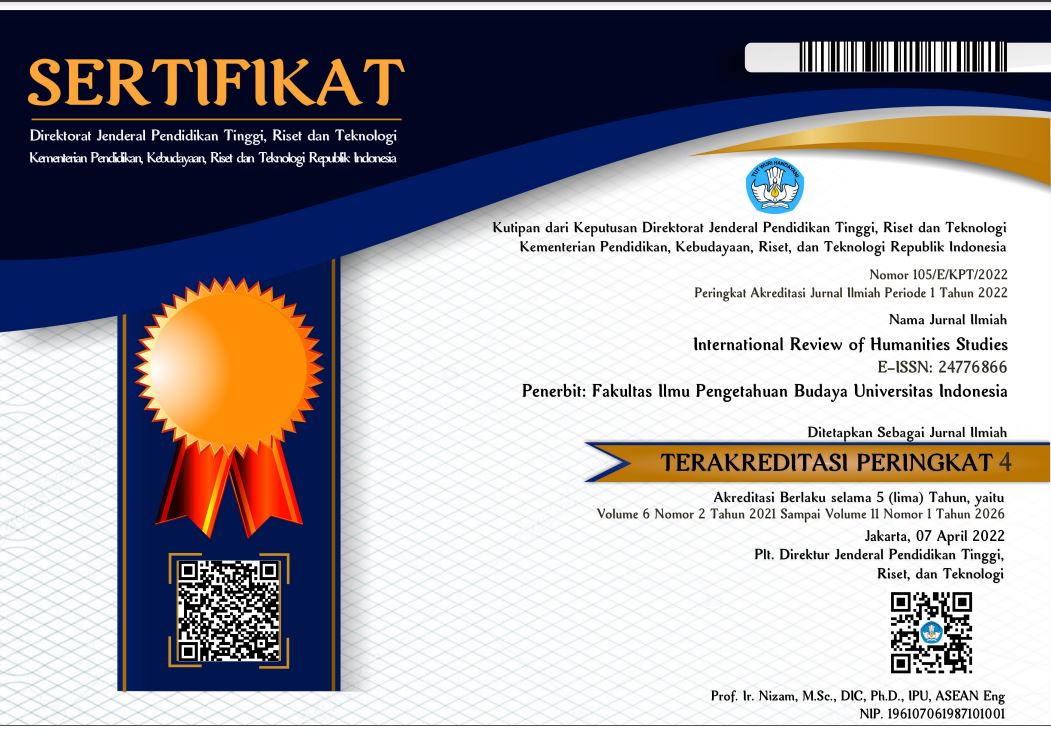International Review of Humanities Studies

Abstract
This paper provides an explanation of the application of phylogenetic analysis, derived from biology, to be applied in archaeology with the aim of observing evolutionary phenomena, the development of ideas, and the dissemination of ideas from material culture. Phylogenetics will be applied to data on anthropomorphic motifs at five rock art sites in West Sumatra: Gua Lidah Air, Gua Runjo, Ngalau Tompok Syohiah, Batu Basurek, and Gua Basurek. The main stages in this analysis involve collecting representative data in the category of distinctive values from each rock art site. Distinctive values data is obtained through observation and identification of morphological characteristics, such as anthropomorphic postures, body shapes, foot patterns, hand patterns, attributes, and other morphologies, thus forming unique codes for each anthropomorphic rock art. This data is then analysed using phylogenetics to depict the relationships of anthropomorphic motifs at the five rock art sites in West Sumatra. The analysis results show similarities and differences in the depiction of anthropomorphic motifs among the rock art sites in West Sumatra, indicating the dissemination and development of ideas of anthropomorphic designs.
References
Arifin, K., & Permana, C. (2022). Recent rock art sites from West Sumatra. Asian Perspectives, 61(2), 285-316.
Campbell, N. A., Jane, B. R., & Lawrence, G. M. (2003). Biologi. Jakarta: Erlangga.
Cherry, D. (2005). Art : History : Visual : Culture. Malden: Blackwell.
Cochrane, E. E. (2015). Phylogenetic Analysis of Polynesian Ritual Architecture Suggests Extensive Cultural Sharing And Innovation. Journal of the Polynesian Society, 1, 7-46.
Currie, T. E., Meade, A., Guillon, M., & Mace, R. (2013). Cultural phylogeography of the Bantu Languages of sub-Saharan Africa. the Royal Society B, 280, 1-8.
Darwent, J., & O'Brien, M. J. (2006). Using Cladistics to Construct Lineages of Projectile Points from Northeastern Missouri. In S. Stephen, Mapping Our Ancestors: Phylogenetic Approaches in Anthropology and Prehistory (pp. 185-208). New Brunswick: Transaction Publishers.
D'Huy, J. (2013). A phylogenetic approachof mythology and itsarchaeological consequences. Rock Art Research, 30(1), 115-118.
Houkes, W. (2010). Tales of Tools and Trees: Phylogenetic analysis and explanation in evolutionary archaeology. Eindhoven: Eindhoven University of Technology.
Mace, R., & Holden , C. J. (2005). A phylogenetic approach to cultural evolution. Trends in Ecology & Evolution, 20(3), 116-121.
O'Brien, M. J., Darwent, J., & Lyman, R. L. (2001). Cladistics Is Useful for recontructing archaeological phylogenies: paleoindian points from the Southeastern United States. Archaeological Science, 28, 1115-1136.
O'Brien, M. J., Lyman, R. L., Saab, Y., Saab, E., Darwent, J., & Glover, D. S. (2002). Two Issues in Archaeological Phylogenetics: Taxon Construction and Outgroup Selection. Theory Biology, 215, 133-150.
O'Brien, M., Lyman, R., & Darwent , J. (2002). Cladistics and archaeological phylogeny. In Perspectivas Integradoras entre Arqueología y Evolución. Teoría, Métodos y Casos de Aplicación (pp. 175-186). Olavarría: INCUAPA–UNC.
Queiroz , K. d., & Gauthier, J. (1992). Phylogenetic Taxonomy. Annual Review of Ecology and Systematics, 23, 449-480.
Radjabovich, M. R. (2021). The Leading Role of the Pencil Sketch in the Visual Arts. International Journal on Integrated Education, 4(7), 1-3.
Rivero, D. G., & O'Brien, M. J. (2014). Phylogenetic Analysis Shows That Neolithic Slate Plaques from the Southwestern Iberian Peninsula Are Not Genealogical Recording Systems. PLOS One, 9(2), 1-18.
Staton, J. L. (2015). Understanding phylogenies: Constructing and interpreting phylogenetic. Journal of the South Carolina Academy of Science, 13(1), 24-29.
Straffon, L. (2019). The uses of cultural phylogenetics in archaeology. In A. M. Prentiss, Handbook or Evolutionary Research in Archaeology (pp. 149-160). Springer.
Susilowati, N. (2020). Aktivitas Pemanfaatan Gua Dan Ceruk Di Nagari Situmbuk, Tanah Datar - Sumatera Barat. Berkala Arkeologi SANGKHAKALA, 22(2), 96-110.
Susilowati, N., & Nasoichah, C. (2018). Identifikasi dan pemaknaan simbol-simbol pada gambar cadas di Ngalau Tompok Syohiah I, NAgari Situmbuk, Sumatera Barat. Berkala Arkeologi Sangkhala, 21(1), 56-79.
Tehrani, J., & Collard, M. (2002). Investigating cultural evolution through biological phylogenetic analyses of Turkmen textiles. Journal of Antropological & Archaeology, 21, 443-463.
Tripp, A. J. (2016). A Cladistics Analysis Exploring Regional Patterning of the Anthropomorphic Figurines from the Gravettian. In L. M. Straffon, & M. L. Straffon (Ed.), Cultural Phylogenetics: Concepts and Applications Archaeology (pp. 179-202). Springer International Publishing Switzerland.
Wiradnyana, K., Setiawan, T., & Hidayati, D. (2018). Gambar cadas di Ngalau Tompok Syohiah I dalam kaitannya dengan budaya pertanian. Berkala Arkeologi Sangkhala, 21(1), 35-55.
Recommended Citation
Chair, Muhammad Faisal and Akbar, Ali
(2024)
"PHYLOGENETIC ANALYSIS OF ANTHROPOMORPHIC ROCK ART: A STUDY OF MATERIAL CULTURE EVOLUTION,"
International Review of Humanities Studies: Vol. 9:
No.
2, Article 9.
DOI: 10.7454/irhs.v9i2.1312
Available at:
https://scholarhub.ui.ac.id/irhs/vol9/iss2/9
Included in
Anthropology Commons, Art and Design Commons, Creative Writing Commons, Cultural Heritage Law Commons, Education Law Commons, Film and Media Studies Commons, History Commons, Intellectual Property Law Commons, International and Area Studies Commons, Legal Writing and Research Commons, Linguistics Commons, Museum Studies Commons, Philosophy Commons, Urban Studies and Planning Commons



